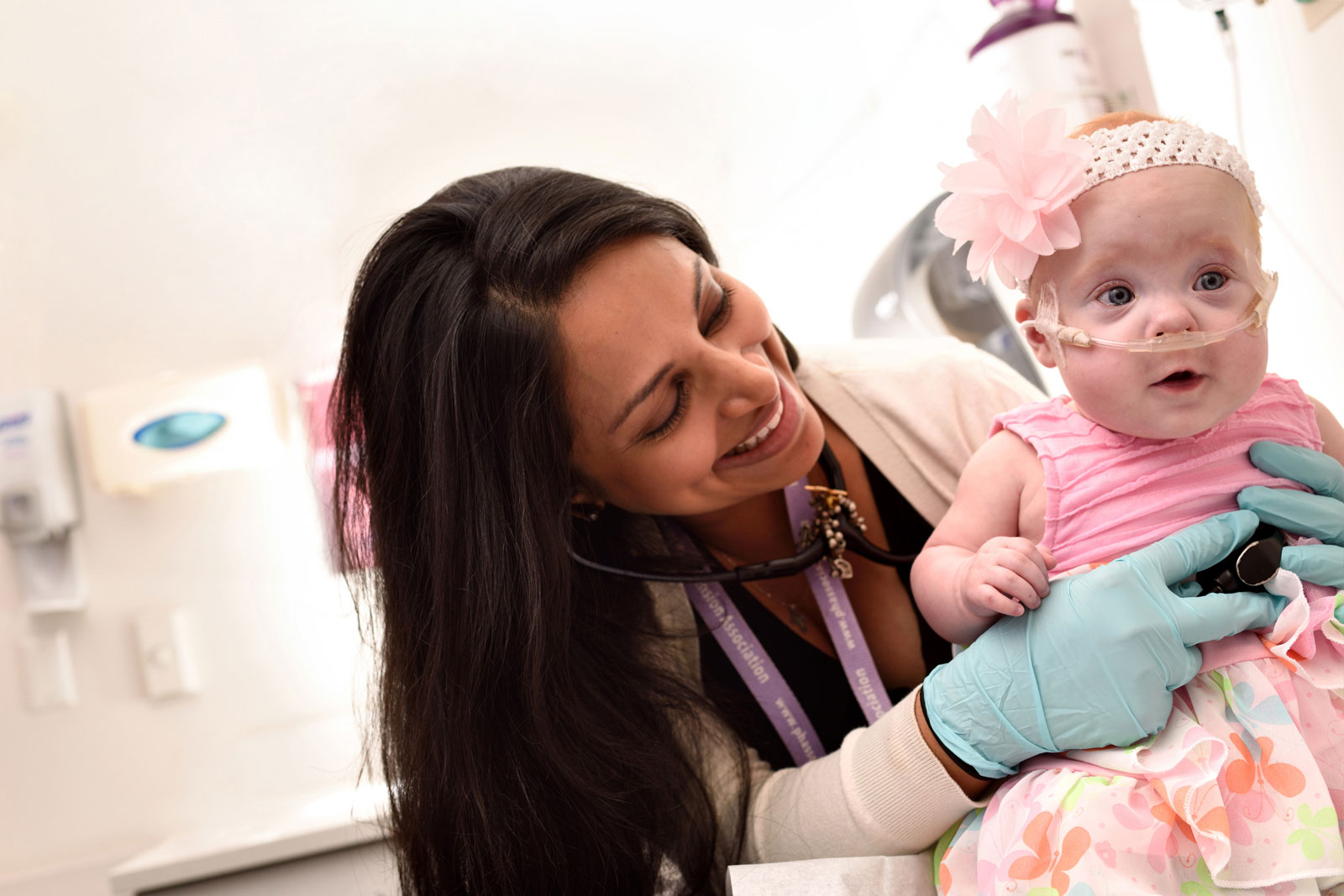

Texas Children’s Hospital
Ranked the best place to treat children for pulmonary disease
In June 2016, Pulmonary Medicine became Texas Children’s first service to be ranked No. 1 in the nation by U.S. News & World Report. Pulmonary Medicine’s breadth and depth of services, and unparalleled expertise in lung transplants, pulmonary hypertension and rare lung diseases – among many other subspecialty programs – have led to remarkable patient outcomes year after year.
“Our ranking reflects our team’s diverse expertise and constant commitment to providing the most innovative treatments possible to our patients and families,” said Chief of Pulmonary Medicine Dr. Peter Hiatt. “It motivates us to do better, to be better, with the ultimate goal of optimizing the best outcomes for these children in need.”
With 25 pulmonologists on staff and nine subspecialty programs, Texas Children’s is among the largest pediatric pulmonary medicine sections in the country.
Lung Transplant Program
As home to the highest volume pediatric lung transplant program in the country, Texas Children’s Hospital accounts for a high percent of all pediatric lung transplants in the U.S. and is one of only two children’s hospitals performing approximately 10 pediatric lung transplants per year on an average annual basis.
Since the program’s launch in 2002, more than 180 patients have received bilateral lung transplants, and in 2013, the team transplanted the lungs of more children than any other center in the world. Heart-lung and liver-lung transplants account for approximately 6 percent of the total.
“We’re doing more lung transplants in children 3 years old and younger than most of our competitors and with excellent survival rates,” said Texas Children’s Lung Transplant Program Medical Director Dr. George Mallory. “Besides being the most active program in the nation, we have devoted our resources to producing outstanding clinical outcomes. Our one-year and three-year lung transplant survival rates are among the highest in the country.”
Compared to the national average of 86 percent, Texas Children’s lung transplant survival rate after one year is 89 percent. The three-year patient survival rate after lung transplant is 89 percent – 17 percent higher than the national average of 72 percent.
The success of the program can be attributed to the expertise of our cardiovascular surgeons specializing in lung transplantation, our capability in extracorporeal membrane oxygenation as a bridge to transplant, and the multidisciplinary collaboration in the care of our patients before and after transplant.

Pulmonary Hypertension Program
As an accredited center of excellence, Texas Children’s world-renowned Pulmonary Hypertension Program treats more than 184 patients each year and is one of the few pulmonary hypertension programs in the nation dedicated to pediatrics.
The pulmonary hypertension program recently earned accreditation from the Pulmonary Hypertension Association (PHA), and it is one of only six pediatric institutions nationwide – and the only one in the southwest – f to earn this high distinction.
“This accreditation reflects the exceptional care that our program provides for pulmonary hypertension patients,” said Texas Children’s pulmonologist Dr. Nidhy Varghese. “It is an honor to collaborate with other pulmonary hypertension specialists from across the country to advance the understanding and treatment of this life-threatening lung condition that can affect both heart and lung function.”
To be designated as an accredited Pulmonary Hypertension Care Center, a program must demonstrate dedication to making proper diagnoses and have the capacity to appropriately and comprehensively manage patients through a set of criteria established by the PHA’s Scientific Leadership Council and Pulmonary Hypertension Care Center Oversight Committee.
“Pulmonary hypertension is a rare disease that requires care from highly trained specialists,” said Mallory, who also is director of Texas Children’s Pulmonary Hypertension Program. “PHA-designated comprehensive care centers are committed to providing advanced care and achieving the best possible outcomes.”
Unlike other pediatric pulmonary hypertension programs, Texas Children’s program has one of the largest, most comprehensive pediatric teams in the nation, including medical providers, nurses, social workers, nutritionists, pharmacists and physical therapists. In addition, the pulmonary team works closely with many other Texas Children’s subspecialists in cardiology, critical care medicine, neonatology and the lung transplant service.
“I think the synergism of having the pulmonary hypertension program in the same section as the Lung Transplant Program is an attractive nexus for referring physicians and families,” Mallory said.
Rare Lung Disease Program
One of the key elements that separates Texas Children’s Pulmonary Medicine from other programs is its ability to treat rare lung disorders. Many of these complex patients are referred to Texas Children’s for care because their local physicians are unable to diagnosis and treat their medical issues.
“Not enough is known about some of these rare diseases,” said Dr. Manual Silva-Carmona, director for the Rare and Interstitial Lung Disease Program at Texas Children’s and one of only a handful of U.S. physicians board certified in both pediatric pulmonology and critical care medicine. “We are committed to collaborating with other pediatric specialists to better understand, diagnose and treat rare lung diseases to improve outcomes for our patients.”
Because rare lung disease has the potential to affect multiple organs, Silva-Carmona said the ability to provide accurate diagnoses and appropriate care across multiple disciplines – immunology, rheumatology, genetics, transplant medicine, diagnostic imaging and pathology – is what makes Texas Children’s Pulmonary Medicine program so unique.
His team also works closely with the vascular anomalies and bone marrow transplant programs, which have attracted patients from all around the nation and the world to Texas Children’s.
Looking to the future
In order to be ranked highly by U.S. News, Hiatt said a program must have excellent outcomes in various disease processes and a large, viable patient volume to develop expertise in multiple subspecialty areas.
“As a regional, national and international pediatric subspecialty referral site, we’ve been able to grow and develop our programs, resulting in a full complement of pulmonary services within our section,” Hiatt said. “We don’t have to refer out – our multidisciplinary support, expertise and resources are right here, housed in one central location.”

